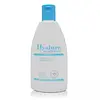What's inside
What's inside
 Key Ingredients
Key Ingredients

 Benefits
Benefits

 Concerns
Concerns

No concerns
 Ingredients Side-by-side
Ingredients Side-by-side

Water
Skin ConditioningSodium Laureth Sulfate
CleansingPropylene Glycol
HumectantCocamidopropyl Betaine
CleansingPEG-150 Distearate
EmulsifyingSalicylic Acid
MaskingSodium Chloride
MaskingPhenoxyethanol
PreservativeGlycerin
HumectantSodium Hydroxide
BufferingDisodium EDTA
Styrene/Acrylates Copolymer
Sodium Benzoate
MaskingSodium Lauroyl Oat Amino Acids
CleansingPolyquaternium-39
Polyquaternium-7
Squalane
EmollientButylene Glycol
HumectantFomes Officinalis Extract
Skin ProtectingAvena Sativa Kernel Extract
AbrasiveEthylhexylglycerin
Skin ConditioningTrehalose
HumectantUrea
BufferingGlycyrrhiza Glabra Root Extract
BleachingOpuntia Ficus-Indica Stem Extract
Skin ConditioningPentylene Glycol
Skin ConditioningSerine
MaskingTerminalia Ferdinandiana Fruit Extract
AntioxidantAlgin
MaskingAnthemis Nobilis Flower Extract
MaskingCalendula Officinalis Flower Extract
MaskingCaprylyl Glycol
EmollientCentaurea Cyanus Flower Extract
AstringentChamomilla Recutita Flower Extract
MaskingDisodium Phosphate
BufferingGlyceryl Polyacrylate
Hypericum Perforatum Flower/Leaf/Stem Extract
Skin ConditioningPEG-40 Hydrogenated Castor Oil
EmulsifyingPotassium Phosphate
BufferingPotassium Sorbate
PreservativePullulan
Sodium Hyaluronate
HumectantTilia Cordata Flower Extract
Skin ConditioningWater, Sodium Laureth Sulfate, Propylene Glycol, Cocamidopropyl Betaine, PEG-150 Distearate, Salicylic Acid, Sodium Chloride, Phenoxyethanol, Glycerin, Sodium Hydroxide, Disodium EDTA, Styrene/Acrylates Copolymer, Sodium Benzoate, Sodium Lauroyl Oat Amino Acids, Polyquaternium-39, Polyquaternium-7, Squalane, Butylene Glycol, Fomes Officinalis Extract, Avena Sativa Kernel Extract, Ethylhexylglycerin, Trehalose, Urea, Glycyrrhiza Glabra Root Extract, Opuntia Ficus-Indica Stem Extract, Pentylene Glycol, Serine, Terminalia Ferdinandiana Fruit Extract, Algin, Anthemis Nobilis Flower Extract, Calendula Officinalis Flower Extract, Caprylyl Glycol, Centaurea Cyanus Flower Extract, Chamomilla Recutita Flower Extract, Disodium Phosphate, Glyceryl Polyacrylate, Hypericum Perforatum Flower/Leaf/Stem Extract, PEG-40 Hydrogenated Castor Oil, Potassium Phosphate, Potassium Sorbate, Pullulan, Sodium Hyaluronate, Tilia Cordata Flower Extract
 Reviews
Reviews

Ingredients Explained
These ingredients are found in both products.
Ingredients higher up in an ingredient list are typically present in a larger amount.
Ethylhexylglycerin (we can't pronounce this either) is commonly used as a preservative and skin softener. It is derived from glyceryl.
You might see Ethylhexylglycerin often paired with other preservatives such as phenoxyethanol. Ethylhexylglycerin has been found to increase the effectiveness of these other preservatives.
Phenoxyethanol is a preservative that has germicide, antimicrobial, and aromatic properties. Studies show that phenoxyethanol can prevent microbial growth. By itself, it has a scent that is similar to that of a rose.
It's often used in formulations along with Caprylyl Glycol to preserve the shelf life of products.
Sodium Hyaluronate is hyaluronic acid's salt form. It is commonly derived from the sodium salt of hyaluronic acid.
Like hyaluronic acid, it is great at holding water and acts as a humectant. This makes it a great skin hydrating ingredient.
Sodium Hyaluronate is naturally occurring in our bodies and is mostly found in eye fluid and joints.
These are some other common types of Hyaluronic Acid:
Learn more about Sodium HyaluronateWater. It's the most common cosmetic ingredient of all. You'll usually see it at the top of ingredient lists, meaning that it makes up the largest part of the product.
So why is it so popular? Water most often acts as a solvent - this means that it helps dissolve other ingredients into the formulation.
You'll also recognize water as that liquid we all need to stay alive. If you see this, drink a glass of water. Stay hydrated!
Learn more about Water